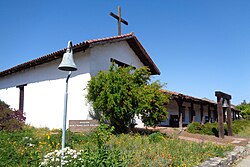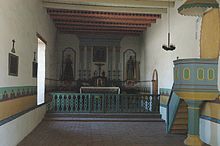
The Spanish missions in California formed a series of 21 religious outposts or missions established between 1769 and 1833 in what is now the U.S. state of California. The missions were established by Catholic priests of the Franciscan order to evangelize indigenous peoples backed by the military force of the Spanish Empire. The missions were part of the expansion and settlement of New Spain through the formation of Alta California, expanding the empire into the most northern and western parts of Spanish North America. Civilian settlers and soldiers accompanied missionaries and formed settlements like the Pueblo de Los Ángeles.

Mission San Antonio de Padua is a Spanish mission established by the Franciscan order in present-day Monterey County, California, near the present-day town of Jolon. Founded on July 14, 1771, it was the third mission founded in Alta California by Father Presidente Junípero Serra. The mission was the first use of fired tile roofing in Upper California. Today the mission is a parish church of the Diocese of Monterey and is no longer active in the mission work which it was set up to provide.

Mission San Gabriel Arcángel is a Californian mission and historic landmark in San Gabriel, California. It was founded by Spaniards of the Franciscan order on "The Feast of the Birth of Mary," September 8, 1771, as the fourth of what would become twenty-one Spanish missions in California. San Gabriel Arcángel was named after the Archangel Gabriel and often referred to as the "Godmother of the Pueblo of Los Angeles."

Mission Santa Clara de Asís is a Spanish mission in the city of Santa Clara, California. The mission, which was the eighth in California, was founded on January 12, 1777, by the Franciscans. Named for Saint Clare of Assisi, who founded the order of the Poor Clares and was an early companion of St. Francis of Assisi, this was the first California mission to be named in honor of a woman.

Mission San José is a Spanish mission located in the present-day city of Fremont, California, United States. It was founded on June 11, 1797, by the Franciscan order and was the fourteenth Spanish mission established in California. The mission is the namesake of the Mission San José district of Fremont, which was an independent town subsumed into the city when it was incorporated in 1957. The Mission entered a long period of gradual decline after Mexican secularization act of 1833. After suffering decline, neglect and earthquakes most of the mission was in ruins. Restoration efforts in the intervening periods have reconstructed many of the original structures. The old mission church remains in use as a chapel of Saint Joseph Catholic Church, a parish of the Diocese of Oakland. The museum also features a visitor center, museum, and slide show telling the history of the mission.
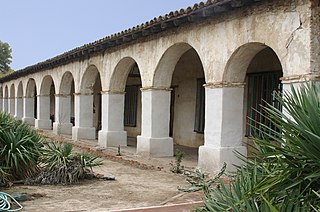
Mission San Miguel Arcángel is a Spanish mission in San Miguel, California. It was established on July 25, 1797, by the Franciscan order, on a site chosen specifically due to the large number of Salinan Indians that inhabited the area, whom the Spanish priests wanted to evangelize.
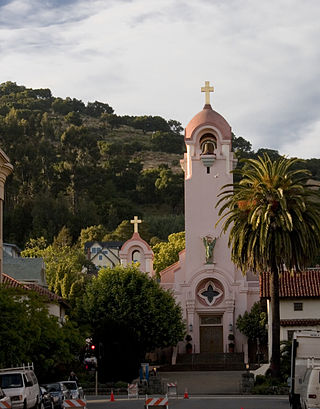
Mission San Rafael Arcángel is a Spanish mission in San Rafael, California. It was founded in 1817 as a medical asistencia ("sub-mission") of Mission San Francisco de Asís. It was a hospital to treat sick Native Americans, making it Alta California's first sanitarium. The weather was much better than in San Francisco, which helped the ill get better. It was not intended to be a stand-alone mission, but nevertheless grew and prospered and was granted full mission status on October 19, 1822.
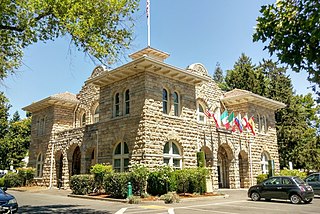
Sonoma is a city in Sonoma County, California, United States, located in the North Bay region of the San Francisco Bay Area. Sonoma is one of the principal cities of California's Wine Country and the center of the Sonoma Valley AVA. Sonoma's population was 10,739 as of the 2020 census, while the Sonoma urban area had a population of 32,679. Sonoma is a popular tourist destination, owing to its Californian wineries, noted events like the Sonoma International Film Festival, and its historic center.
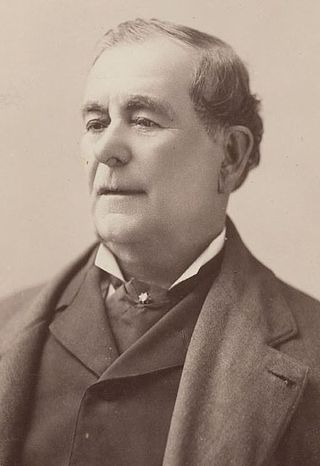
Don Mariano Guadalupe Vallejo was a Californio general, statesman, and public figure. He was born a subject of Spain, performed his military duties as an officer of the Republic of Mexico, and shaped the transition of Alta California from a territory of Mexico to the U.S. state of California. He served in the first session of the California State Senate. The city of Vallejo, California, is named after him, and the nearby city of Benicia is named after his wife.

The Coast Miwok are an Indigenous people of California that were the second-largest tribe of the Miwok people. Coast Miwok inhabited the general area of modern Marin County and southern Sonoma County in Northern California, from the Golden Gate north to Duncans Point and eastward to Sonoma Creek. Coast Miwok included the Bodega Bay Miwok, or Olamentko (Olamentke), from authenticated Miwok villages around Bodega Bay, the Marin Miwok, or Hookooeko (Huukuiko), and Southern Sonoma Miwok, or Lekahtewutko (Lekatuit). While they did not have an overarching name for themselves, the Coast Miwok word for people, Micha-ko, was suggested by A. L. Kroeber as a possible endonym, keeping with a common practice among tribal groups and the ethnographers studying them in the early 20th Century and with the term Miwok itself, which is the Central Sierra Miwok word for people.
Luis Antonio Argüello was the first Californio (native-born) governor of Alta California, and the first to take office under Mexican rule. He was the only governor to serve under the First Mexican Empire and also served as acting governor under the subsequent provisional government, which preceded the First Mexican Republic.

The North Bay is a subregion of the San Francisco Bay Area, in California, United States. The largest city is Santa Rosa, which is the fifth-largest city in the Bay Area. It is the location of the Napa and Sonoma wine regions, and is the least populous and least urbanized part of the Bay Area. It consists of Marin, Napa, Solano and Sonoma counties.
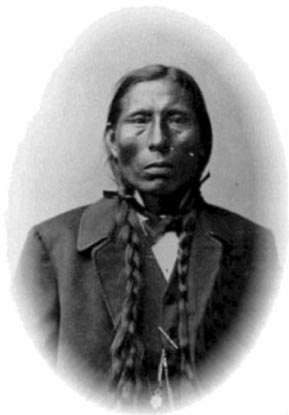
The Suisunes were a Patwin tribe of Wintun people, originating in the Suisun Bay and Suisun Marsh regions of Solano County in Northern California. Their traditional homelands stretched between what is now Suisun City, Vacaville and Putah Creek around 200 years ago. The Suisunes' main village, Yulyul, is believed to be where Rockville, California is located today. Father Abella, visitor to the tribe in 1811, indicated they resided in the present location of Fairfield, north of the Suisun Bay. One of the Suisunes' primary food sources was acorns. Their diet also included fish as well as miner's lettuce. Their huts were conical wikiups made of rushes or tule thatch.

Rancho Petaluma Adobe is a historic ranch house in Sonoma County, California. It was built from adobe bricks in 1836 by order of Mariano Guadalupe Vallejo. It was the largest privately owned adobe structure built in California and is the largest example of the Monterey Colonial style of architecture in the United States. A section of the former ranch has been preserved by the Petaluma Adobe State Historic Park and it is both a California Historic Landmark and a National Historic Landmark. The Rancho Petaluma Adobe State Historic Park is located on Adobe Road on the east side of the present-day town of Petaluma, California.

Sem-Yeto was a leader of the Suisunes, a Patwin people of the Suisun Bay region of northern California. Baptized as Francisco Solano and also known as Chief Solano, he was a notable Native American leader in Alta California because of his alliance, friendship, and eventually the support of his entire tribe to General Mariano Guadalupe Vallejo of Sonoma, in military and political excursions around Sonoma County and the San Francisco Bay Area. By allying with Vallejo and assisting him in quelling Native American uprisings north and west of Sonoma between 1836 and 1843, Sem-Yeto is regarded as a controversial historical figure. The California county of Solano is named for him.
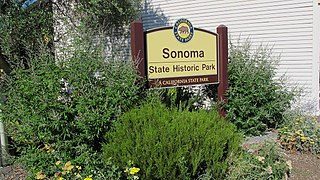
Sonoma State Historic Park is a California State Park located in the center of Sonoma, California. The park consists of six sites: the Mission San Francisco Solano, the Sonoma Barracks, the Blue Wing Inn, La Casa Grande, Lachryma Montis, and the Toscano Hotel.

The Blue Wing Inn in Sonoma, California, was one of the first hotels built in the state north of San Francisco. What began as the first property transfer in the new Pueblo de Sonoma and a simple adobe residence transformed with time and the addition of more rooms into a storied landmark. During the California Gold Rush it was used by miners going to and from the gold fields and by the U.S. Army soldiers stationed in Sonoma. After many years, owners and uses - the Blue Wing Inn was purchased by the State of California in 1968 and is currently under study for its best use as part of Sonoma State Historic Park.

The Sonoma Barracks is a two-story, wide-balconied, adobe building facing the central plaza of the City of Sonoma, California. It was built by order of Mariano Guadalupe Vallejo to house the Mexican soldiers that had been transferred from the Presidio of San Francisco in 1835. The Presidio Company and their commander, Vallejo, were also responsible for controlling the Native Americans living on the northern border of Mexican California.

The Mexican Secularization Act of 1833, officially called the Decree for the Secularization of the Missions of California, was an act passed by the Congress of the Union of the First Mexican Republic which secularized the Californian missions. The act nationalized the missions, transferring their ownership from the Franciscan Order of the Catholic Church to the Mexican authorities.

Don Cayetano Juárez was a Californio ranchero and soldier, who played a prominent role in the 19th century North Bay, particularly in Napa County. The home he built, the Cayetano Juárez Adobe, is the oldest building in the city of Napa.
